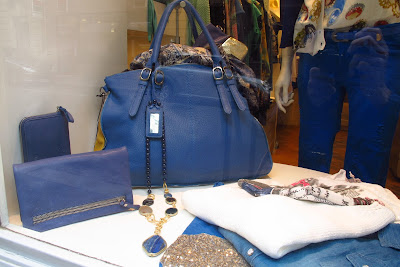I've found that having a particular item to search out actually makes you look even closer at everything. On a previous trip, I decided on the spur of the moment that I was going to look for 'green things' and try to take a green photo everyday. Green, it turned out was not the easiest color to find but once we started looking for it~it seemed to be everywhere.
So as part of my trip planning, I made a list of possible themes. Colors was at the top of the list. For this trip I was going to do blue. While walking the first couple days, we noticed a definite trend in the shop windows. Orange~obviously THE color to be wearing. So orange and blue were the 'theme colors' for Paris 5.
The first orange photo was easy. This little ball was one of the lamps in our apartment. It made the perfect backdrop for our May Day Lily of the Valley.
I have to admit, I think these are just about the ugliest shoes I saw; we passed this shop almost twice a day.
Maybe this is the same shop~they do change their windows often.
I thought these lace shorts were quite unique. The first blue item that I found.
(I was shopping last week and found that lace shorts are "in".)
Little girls get to wear orange too.
I coveted this scarf but couldn't justify 79 euros. I was really tempted though.
I don't like to take photos of people on the street but this orange coat screamed for a photo.
This little tourist tram is new~at least for us. We've seen a white one in Montmartre but not in the city by the Ile de la Cite. I didn't see any advertisements so have no idea where it goes.
ORANGE shops are everywhere....they sell products for mobile phones. A Parisian RadioShack.
Not something I would wear, but it did get my attention.
Outside seating at a small bar.
I found some blue at the Mineralogy Museum~ Lapis lazuli.
One of the clocks on the wall at the Architecture Museum;
each unique clock designated a different time zone.
Here you are ~a whole outfit.
The butterfly dress was pretty. This was an upscale shop on Rue Victor Hugo that we passed
on the way to the Arc de Triomphe.
Some shades of orange were more appealing than others. I prefer the cool oranges.
I didn't dare run over and take a photo of this woman.
She was walking rather fast, so it's probably not in focus.
Shops with kitchen gadgets are really fun. Sometimes we were at a loss at identifying the item. I guess this is a juicer for your fresh squeezed orange presse in a goblet.
The item that looks like a boat is actually a serving dish for dip. The spreading knife sits in the lid.
The blue juicer is displayed upside-down
Pick your shade.
I asked Woody to keep his eye open for something orange in the men's shops.
These are those little remote controlled puppies that run around and yelp. This was near the Eiffel Tower.
Little puppies begging the tourists to take them home.
I love this bike! It was parked at the Louvre.
Orange canaries in the pet shop~blue backdrop.
More accessories for your orange wardrobe.
It took some time before I found a shop that wasn't showing orange. I was beginning to give up on blue.
Indian tourists at the Trocadero
Finally found some men's clothes~maybe for that weekend in Cannes.
(With those yellow loafers in the photo above)
I was so surprised to find an orange scooter.
Robes/cover-ups in a tourist shop on the Rue de Rivoli.
An elegant little boutique in the Marais~oriental style clothing.
Ballet flats (all French girls wear these).
I really preferred the blue ones but then I'd have to buy a whole outfit to match.
This photo does not do this window justice. The store is very large by Paris standards. Those huge blue net pom-poms took over the whole window with only 2 mannequins displaying the lingerie. Tam-Tam specializes in loungewear, bathing suits and lingerie.
I wish I could have gotten a photo without all the reflections. These are Denver Bronco colors. I hit the jackpot with orange and blue in one window. (They are complimentary colors)
That's it for the colors theme....more themed posts to come.















































































